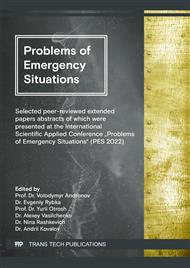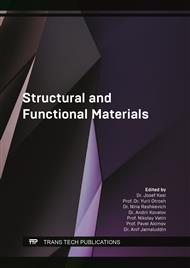[1]
O. Popov, A. Iatsyshyn, V. Kovach, V. Artemchuk, D. Taraduda, V. Sobyna, D. Sokolov, M. Dement, T. Yatsyshyn, I. Matvieieva, Analysis of possible causes of NPP emergencies to minimize risk of their occurrence. Nuclear and Radiation Safety, 1 81 (2019) 75–80.
DOI: 10.32918/nrs.2019.1(81).13
Google Scholar
[2]
O. Popov, A. Iatsyshyn, V. Kovach, V. Artemchuk, D. Taraduda, V. Sobyna, D. Sokolov, M. Dement, T. Yatsyshyn, Conceptual approaches for development of informational and analytical expert system for assessing the NPP impact on the environment. Nuclear and Radiation Safety, (2018).
DOI: 10.32918/nrs.2018.3(79).09
Google Scholar
[3]
M.V. Kustov, V.D. Kalugin, V.V. Deineka, G.M. Shabanova, A.M. Korohodska, E.D. Slepuzhnikov, D.M. Deyneka, Radioprotective cement for long-term storage of nucle weste. Voprosy khimii i khimicheskoi tekhnologii, 2 (2020) 73-81.
DOI: 10.32434/0321-4095-2020-129-2-73-81
Google Scholar
[4]
Popov O., Iatsyshyn A., Kovach V., Artemchuk V., Taraduda D., Sobyna V., Sokolov D., Dement M., Hurkovskyi V., Nikolaiev K., Yatsyshyn T., Dimitriieva D. Physical features of pollutants spread in the air during the emergency at NPPs. Nuclear and Radiation Safety, 4 (84) (2019) 11.
DOI: 10.32918/nrs.2019.4(84).11
Google Scholar
[5]
V.S. Krasnoruckij, I.A. Petel'guzov, V.M. Gricina, Issledovanie processov korrozii materialov aktivnoj zony reaktorov tipa VVER, Fіzikohіmіchna mekhanіka materіalіv. Problemi korozії ta protikorozіjnogo zahistu materіalіv, 8 (2010) 667-674. [in Russian].
Google Scholar
[6]
Popov O., Taraduda D., Sobyna V., Sokolov D., Dement M., Pomaza-Ponomarenko A. Emergencies at Potentially Dangerous Objects Causing Atmosphere Pollution: Peculiarities of Chemically Hazardous Substances Migration. Studies in Systems. Decision and Control, 298 (2020) 151–163.
DOI: 10.1007/978-3-030-48583-2_10
Google Scholar
[7]
Fesenko H., Kliushnikov I., Kharchenko V., Rudakov S., Odarushchenko E. Routing an Unmanned Aerial Vehicle during NPP Monitoring in the Presence of an Automatic Battery Replacement Aerial System. Proceedings - 2020 IEEE 11th International Conference on Dependable Systems, Services and Technologies, DESSERT, 9125080 (2020) 34–39.
DOI: 10.1109/dessert50317.2020.9125080
Google Scholar
[8]
S. Ragimov, V. Sobyna, S. Vambol, V. Vambol, A. Feshchenko, A. Zakora, E. Strejekurov, V. Shalomov, Physical modelling of changes in the energy impact on a worker taking into account high-temperature radiation. Journal of Achievements in Materials and Manufacturing Engineering, 91 1 (2018) 27–33.
DOI: 10.5604/01.3001.0012.9654
Google Scholar
[9]
B. Pospelov, V. Andronov, E. Rybka, O. Krainiukov, K. Karpets, O. Pirohov, I. Semenyshyna, R. Kapitan, A. Promska, O. Horbov, Development of the correlation method for operative detection of recurrent states. Eastern-European Journal of Enterprise, 6/4 102 (2019) 39–46.
DOI: 10.15587/1729-4061.2019.187252
Google Scholar
[10]
Popov, O., Iatsyshyn, A., Sokolov, D., Dement, M., Neklonskyi, I., Yelizarov, A.Terms and conditions Privacy policy Application of virtual and augmented reality at nuclear power plants. Studies in Systems, Decision and Control, 346 (2021) 243-260.
DOI: 10.1007/978-3-030-69189-9_14
Google Scholar
[11]
Y. Hapon, M. Kustov, V. Kalugin, Studying the Effect of Fuel Elements Structural Materials Corrosion on their Operating Life. Materials Science Forum Submitted, 1038 (2021) 108-115.
DOI: 10.4028/www.scientific.net/msf.1038.108
Google Scholar
[12]
P. Barberis, M. Skocic, D. Kaczorowski, D. Perche, Y. Wouters, K. Nowotka, Shadow corrosion: Experiments and modeling. Journal of Nuclear Materials, 523 (2019) 310-319.
DOI: 10.1016/j.jnucmat.2019.06.001
Google Scholar
[13]
Pospelov B., Meleshchenko R., Krainiukov O., Karpets K., Petukhova O., Bezuhla Y., Butenko T., Horinova V., Borodych P., Kochanov E. A method for preventing the emergency resulting from fires in the premises through operative control over a gas medium. Eastern-European Journal of Enterprise Technologies, 10–103 (2020) 6–13.
DOI: 10.15587/1729-4061.2020.194009
Google Scholar
[14]
Pilipenko A., Pancheva H., Reznichenko A., Myrgorod O., Miroshnichenko N., Sincheskul A. The study of inhibiting structural material corrosion in water recycling systems by sodium hydroxide. Eastern-European Journal of Enterprise Technologies, 2 (1–85) (2017) 21–28.
DOI: 10.15587/1729-4061.2017.95989
Google Scholar
[15]
G. Lysell, A. Nystrand, M. Ullberg, Shadow Corrosion Mechanism of Zircaloy. Journal of ASTM International, 2(2005) 1-17.
DOI: 10.1520/jai12374
Google Scholar
[16]
Pilipenko A., Smirnova O., Gura S., Skorynina-Pohrebna O., Khoroshev O., Shkolnikova T. Studying the insulating properties of oxide films obtained on the Ti6A14V alloy in tartaric acid solutions using the method of electrochemical decoration by copper. ARPN Journal of Engineering and Applied Sciences, 15 (15) (2020) 1657–1665.
DOI: 10.23939/chcht15.04.526
Google Scholar
[17]
Shevchenko G., Pilipenko A., Shkolnikova T., Gura S., Smirnova O. Production of Nanosize Interference-colored Oxide Films on the Ti6Al4V Alloy Surface Using the Method of Electrochemical Oxydation in Succinate Eletrolytes. 2020 IEEE 40th International Conference on Electronics and Nanotechnology, ELNANO 2020 – Proceedings, 9088771 (2020) 216–219.
DOI: 10.1109/elnano50318.2020.9088771
Google Scholar
[18]
D. Khmara, Ekspluatatsiia yadernykh enerhoblokiv u ponadproektnyi termin. Svitova praktyka i osoblyvosti protsesu v Ukraini. doslidzhennia Natsionalnyi ekolohichnyi tsentr Ukrainy, 2010 61p. [in Ukrainian].
Google Scholar
[19]
V.V. Chichenin, V.A. Kishnevskij, Issledovanie skorosti korrozii i nakopleniya otlozhenij pri upravleknii cirkulyacionnoj vody v laboratornyh usloviyah. Vostochno-Evropejskij zhurnal peredovyh tekhnologij, 77 (2015) 20-40 [in Russian].
Google Scholar
[20]
V.S. Krasnorutskiy, I.A. Petelguzov, V.M. Gritsina, Issledovaniye vliyaniya VKhR na korrozionnyye protsessy na materialakh aktivnoy zony reaktorov VVER. Voprosy atomnoy nauki i tekhniki, 5 (2010) 58-66 [in Russian].
Google Scholar
[21]
A.Yu. Melekhovec, I.V. Pyshin, Gal'vanicheskaya korroziya cirkonievyh splavov v vodnom teplonositele. Materialy i yadernaya energetika, 2(2020) 52-63 [in Russian].
Google Scholar
[22]
V.V. Krasnoyarskij, G.Ya. Frenkel', R.P. Nosov, Korroziya i zashchita metallov, Metallurgiya,1969. 299 p. [in Russian].
Google Scholar
[23]
Yu.K. Hapon, V.D. Kalugіn, M.V. Kustov, Mekhanіzm vnutrіshn'oї korozії splavu cirkonіyu Zr1Nb V TVELah, Promising Materials and Processes in Applied Electrochemistry, Monograph, 2020. 288 r.
Google Scholar



